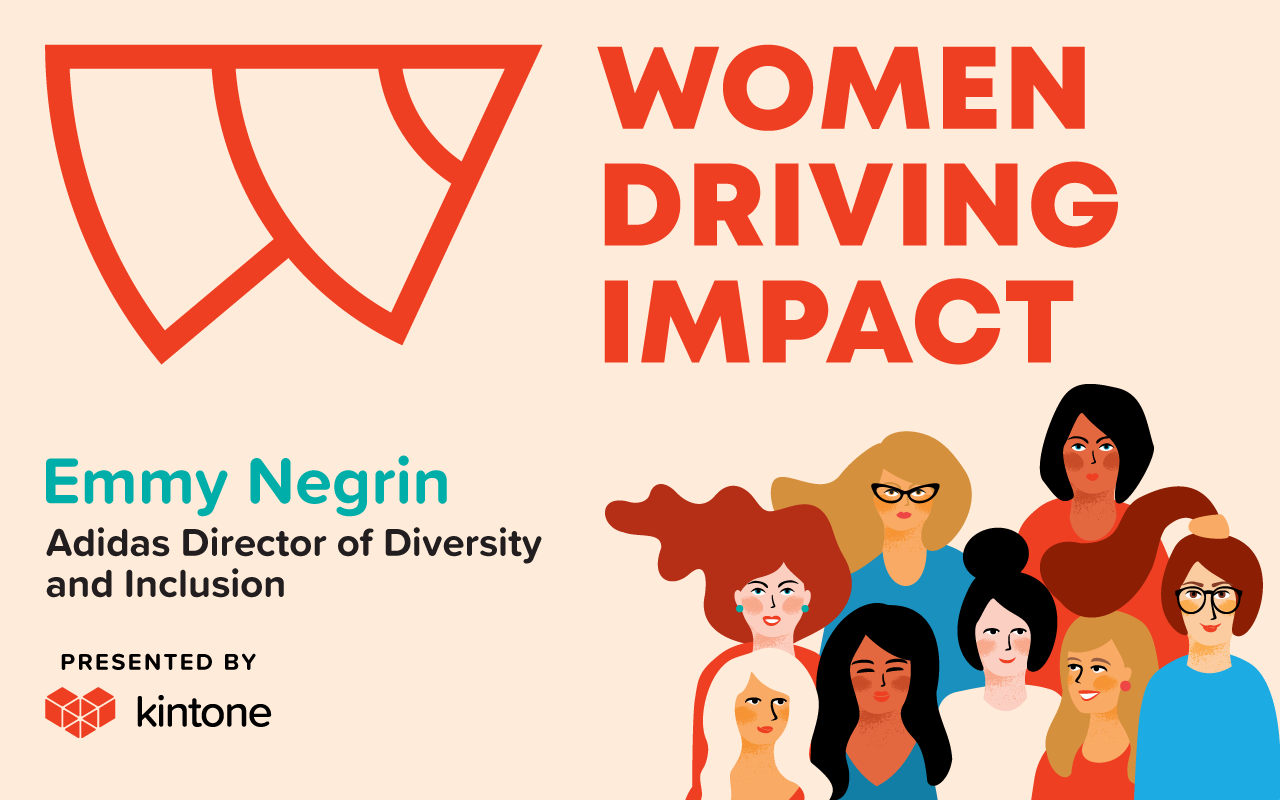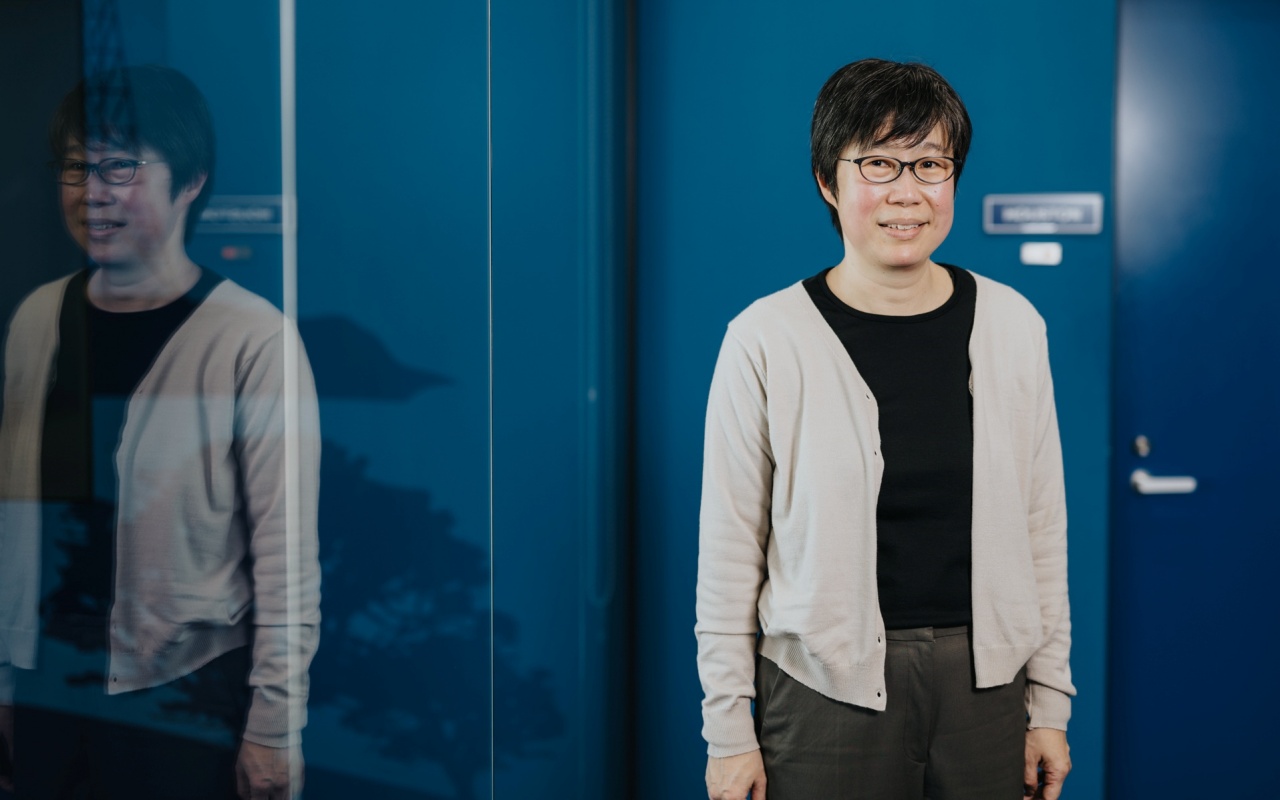How to Build Purpose-Driven and Inclusive Workplaces That Serve Our Community
Interview with Emmy Negrin, director of diversity and inclusion at Adidas

Listen to this podcast episode here:
There's no "one size fits all" approach to making your company more inclusive. The challenges of diversity and inclusion go beyond just ticking boxes and fulfilling metrics.
So how do you build an organization that better reflects its customers, while also promoting psychological safety in the workplace and driving performance with positive leadership? As it turns out, there are things you can do at every level, whether you're a senior manager or just starting out.
In this episode of Women Driving Impact, Emmy Negrin, director of diversity and inclusion at Adidas, spoke to Kintone former marketing director Nicole Jones about how she's driving inclusive company cultures while ensuring companies make services and products that reflect the communities they serve. Their discussion included traits that great leaders possess, how being a queer woman impacts Emmy's leadership style, and tips for advocating for marginalized groups.
Emmy is a social entrepreneur focused on building purpose-driven and inclusive workplaces. In her current role, she's creating a diversity and inclusion strategy focused on company culture and equitable approaches to hiring. Previously, Emmy led diversity and inclusion and social impact at OpenTable in San Francisco, and prior to that managed the Yahoo Employee Foundation, a global mindfulness and social impact grant-making program connecting employees with nonprofits around the world.
Here is an extract of some of the key takeaways from this episode:

Nicole: Tell us a little bit about your professional journey, personal growth, and how you got where you are today.
When I started my career, I thought I was going to be a psychologist. However, I eventually found that it wasn't the career path I thought it was, so I ended up studying international development and social change and obtaining a broader communications degree.
One of the pivotal moments that shifted things for me was when I studied abroad in Namibia and South Africa. The program focused on the reconciliation of apartheid and how to rebuild. I was working with women and children facing domestic violence and abuse, helping this local woman build a microfinance organization. I tell this story because it was actually a project that failed—I didn't understand the cultural context, the deep roots of oppression that those women were facing.
That experience pushed me to rethink the direction of my career. After I moved back to the United States, I worked for a few organizations first on youth leadership development, then on learning and development. That's when I was asked to join Yahoo.
It was this fish out of water moment for me of "What am I doing in this big tech company?" I was focused on trying to bring social change to the world—why would a tech company like Yahoo care about that? The offer opened my eyes to how you can play a role in a big company and influence things like inclusive workplaces. I ended up leading the $10 million Yahoo Employee Foundation, which showed me that big corporations can funnel a lot of money and resources to great organizations all over the world.
After Yahoo, I focused on diversity and inclusion at OpenTable. Then most recently, I joined Adidas, where I also focus on diversity and inclusion.
Nicole: What do you think are some traits that great leaders possess?
Great leaders are authentic in who they are, lead with compassion, and have the confidence of knowing where they're going.
When you're leading a team, people are looking to you to to set the direction. You need confidence, but also the authenticity to recognize that you're really guiding them. Great leaders are mindful of their shadow sides and the areas they get tripped up on. And then leading with compassion is really the "secret sauce" to leadership—recognizing that you're only as good as the sum of your parts. Fostering a team environment where people feel valued and seen for who they are will make them want to work extra hard.
Nicole: How does being a woman impact your leadership style?
I actually identify as a queer women, which is part of who I am and something I'm always aware of. Oftentimes I'm the only woman in the room, talking to male leaders that probably have a lot of assumptions about me. But I feel like many women naturally have the ability to connect with people in a very real way, and that can be a differentiator. If you're trying to pitch a new idea or a new initiative, the ability to connect with someone rather than pushing your ideas down their throat is a very female approach, a bit of a balanced approach to leading something.
It's an empowering thing when you start to recognize that you can use the natural, innate wisdom that women have and lean into that, use that as a way to show up in a more authentic and real way.
Nicole: What are some best practices for listening to and advocating for women, or anyone that might be different from ourselves?
At the foundation, it's about creating psychological safety—creating places where people feel safe. That might look something like: before a meeting starts, sharing your pronouns to avoid making assumptions about the people in the room. When you start to do that, people realize that you're infusing the human element into the conversation. It's about setting a culture that's truly inclusive and creating a culture of belonging.
Also important is being timely, honest and bold when you see inequity happening. I'm a big fan of championing things in the moment. Often, there's a meeting after the meeting where you hear people saying, "I felt like we were talked over a lot," or "My ideas weren't really valued," or "Did you notice that all the men got the credit?" That meeting after the meeting doesn't have to happen. Let's give credit where credit is due and make sure that everyone has an equal opportunity to share their ideas, whether it be in a meeting, a bigger project, or more broadly within an organization.
Nicole: How can someone who's new to this create psychological safety in their organization?
The starting point is to have the education and the language to know what it means to be an inclusive leader. There are a lot of resources available online, so I think start by educating yourself, using team meetings to share what you've learned, and translating that back to what it means for your team.
Then, setting expectations is key—in other words defining norms and working agreements. For example, when I hire anyone or anyone joins my team, I always ask them: What is their natural working style? How do they like to receive feedback? How do they like to receive recognition? When they are at their best, what does that look like? Those questions give insight on how your team members like to be seen and valued.
You can do that in a small way, on an individual basis, but also in a team environment. Each person is a dynamic being; if we're not talking about the human side of how we work together, if we're trying to create one-size-fits-all programs, then we're missing the point. We have to get real and discuss what makes individual people feel safe.

Nicole: What are you doing to encourage diversity at Adidas?
We focus on three things: education and awareness, talent development and growth, and recruitment practices.
Education and awareness starts with a common language, so for instance we're rolling out our "inclusion in the workplace" training. It's mandatory for all leaders, and provides them with toolkits to take back to their teams and say, "This is how I'd like to shift how we work together."
Second is talent development and growth, where we question if we are really looking at diversity and inclusion through every development program that we have. Adidas is a very large global company, so we use data to bust myths. We use metrics to make sure there is an equitable and representative group of people that goes through all levels of training. If managers just nominate their best people for these training programs, that leads to bias. Instead, we set parameters in terms of what an inclusive leader should do to create a culture of belonging.
The next step is when managers are thinking about growing their team, making sure that they understand what diversity means in their specific case. It could mean greater gender balance, or maybe better balance in terms of race, ethnicity or LGBTQ representation. We use data deliberately to make better decisions and grow talent within the organization.
Last but not least is recruiting. We know that our current employee base doesn't very well represent the consumer base and the world that we are trying to serve. So we are doing a lot of work on our outreach strategies, up-skilling and training our recruiters, and educating managers on what unconscious bias means in the hiring process.
Adidas actually has a very diverse employee base working in our retail stores. A lot of companies have this, where they're not very diverse on the corporate side but are in the retail space. Therefore one of the programs we've built is called Adidas Unlimited, which is a pathway for retail employees to get opportunities to work on the corporate side. We look at this as a new standard of eliminating barriers to entry—things like education requirements and where we recruit. This comes back to equity, not everyone being born with the same opportunities. There's a responsibility for big companies to lead the change and recognize there is no blueprint for what a great hire looks like.
Nicole: What about smaller companies? How can individual contributors make an impact?
If you don't have much in place, you can get started by creating a network of employees who get together to voice their different values; express what they want to see differently in your organization. Traditionally, these are called employee resource groups. When you create programs that allow employees to come together at the grassroots level, you will start to see great outcomes, like for example the celebration of different cultural days, or volunteer work within the community.
You can start really small, and over time you will see these activities grow into a core pillar of your company's diversity strategy.
Listen to our previous episode featuring Dr. Carol Langlois, founder of Empowered Tech, at the link below:
This piece was originally written in April 2019 by Nicole Jones for the Kintone blog. Check out the original article here. Adapted for Kintopia by Alex Steullet and Richard Ho.
Writer
Editor

Alex Steullet
Alex is the editor in chief of Kintopia and part of the corporate branding department at Cybozu. He holds an LLM in Human Rights Law from the University of Nottingham and previously worked for the Swiss government.





